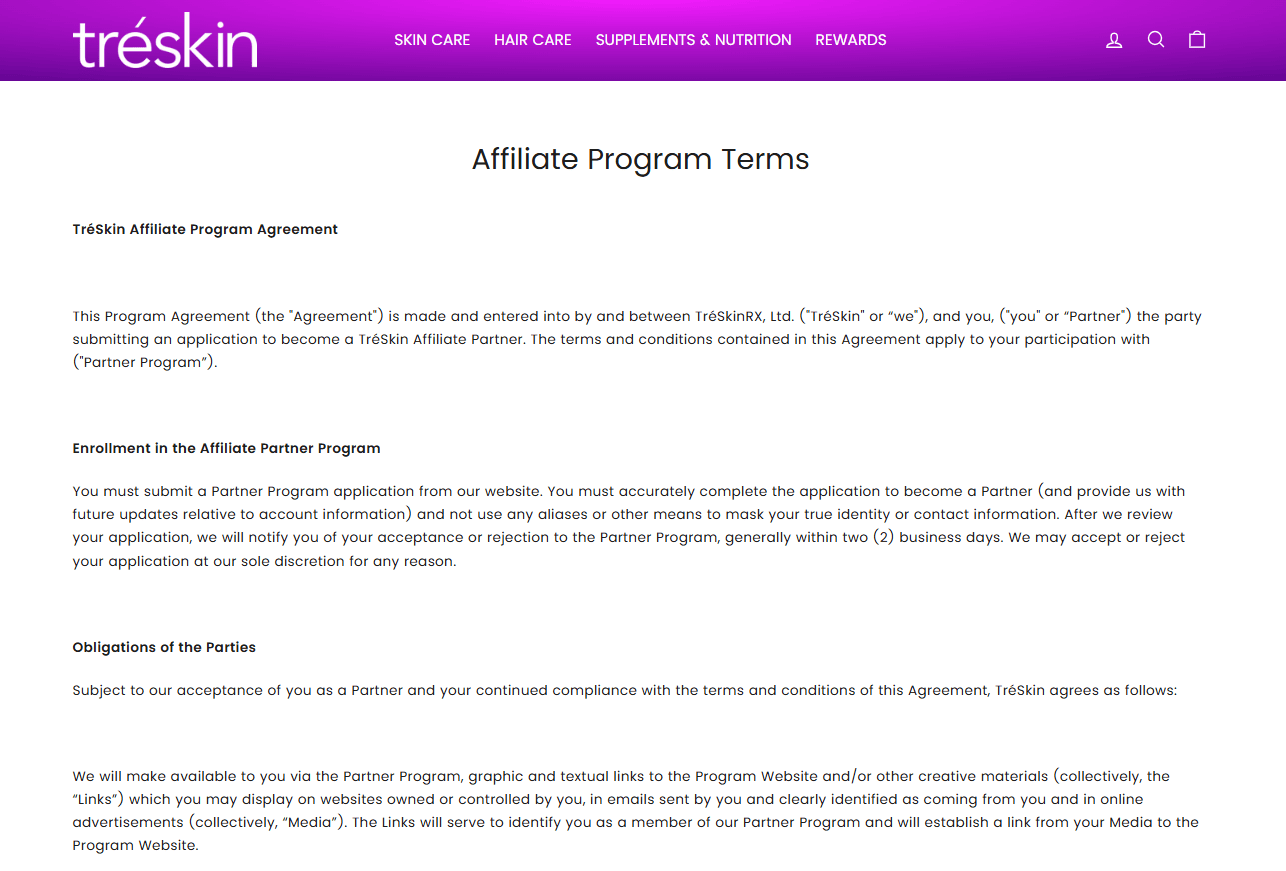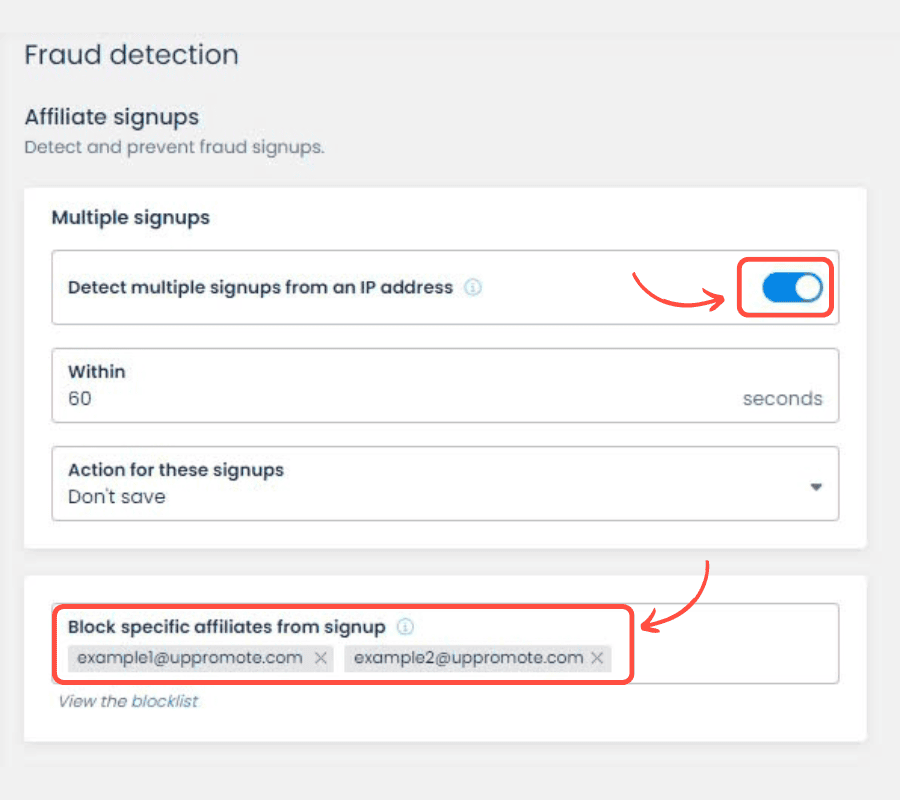Having a solid business plan is essential for success in any industry, and affiliate marketing is no exception. It’s a framework for developing clear strategies to create, run, and manage your affiliate program successfully.
Writing an affiliate marketing business plan from scratch can be challenging, especially for new business owners. But don’t worry, we’ve got you covered.
In this guide, we’ll walk you through the ins and outs of creating an affiliate marketing business plan: why you need one, how to write it effectively, and provide you with 9 ready-to-use templates to explore.
Here are 15 essential elements to include in your affiliate marketing business plan:
- Affiliate Program’s Goals
- Competitive Analysis
- Target Audience
- Financial Plan
- Affiliate Software
- Affiliate Commission Structure
- Affiliate Manager
- Affiliate Program’s Terms & Conditions
- Strategies to Find Affiliates
- Affiliate Outreach
- Marketing and Promotional Materials
- Communication with Affiliates
- Affiliate Training Plan
- Risk Management
- Tracking and Evaluation of Program Success
If you want to create, run, and manage your own affiliate program, choosing reliable and robust affiliate management software is an important factor to include in your plan. Try UpPromote, a top-recommended affiliate management software with a 4.9/5 rating and over 4,000 reviews on the Shopify App Store, to start.
With an easy affiliate program setup, attractive rewards, and robust tracking features, UpPromote is the perfect tool to complement your plan perfectly.
What is An Affiliate Marketing Business Plan?
An affiliate marketing business plan is a detailed document that outlines the goals, resources, and activities you’ll take to grow your affiliate marketing efforts. It’s your blueprint for success, helping you stay focused and organized as you run your affiliate program in ways that align with your business objectives.
Why You Need An Affiliate Marketing Plan?
Anyone desiring a successful business through affiliate marketing should have a sound plan.
Here are the main reasons why:
Strategic direction and clear objectives:
- Defines goals: An affiliate marketing plan helps you set clear, measurable goals. For example, increase sales by a certain percentage or expand into new markets.
- Focus efforts: A plan works like a map. This means it guides you to concentrate your efforts on practical strategies, not to scatter your resources.
Effective budget management
- Allocate resources wisely: Planning allows you to allocate your budget efficiently. For instance, determine how much to invest in commissions, tools, and affiliate incentives.
- Maximizes ROI: Outline costs and expected returns. From there, you can optimize your investment to achieve the highest return on investment (ROI).
- Control expenses: You can set financial boundaries and monitor expenses against the plan to prevent overspending.
Targeted Affiliate Recruitment
- Identify ideal partners: A plan helps you identify the types of affiliates that best match your brand and target audience.
- Focus on quality, not quantity: You seek high-quality affiliates who can deliver results, not just any partners.
- Build strong relationships: Planning lets you create strategies to nurture relationships with affiliates.
Performance Tracking and Optimization
- Set KPIs: A plan lets you set KPIs to measure your affiliate marketing success. For example, conversion rates, average order value, etc.
- Facilitate data analysis: Regular monitoring and analysis based on a plan help you see what works and what doesn’t. Then, refine strategies, optimize campaigns, and improve affiliate performance.
Competitive Advantage
- Differentiate your program: Identify the unique selling point in your plan. This will set your affiliate program apart from competitors and make publishers choose to work with you over others.
- Innovate marketing strategies: Planning encourages creativity and new tactics to beat the competition.
Legal Compliance and Risk Mitigation
- Avoid legal problems: A comprehensive plan ensures your program meets laws on data protection and disclosure.
- Reduce risks and maintain brand integrity: Include well-defined affiliate rules in your plan to reduce risks and safeguard your brand. Outline guidelines to prevent unethical practices and ensure affiliates promote your products in a way that matches your brand values and message.
9 Ready-made Affiliate Marketing Business Plan Templates
Creating an affiliate marketing business plan becomes much easier when you have templates at hand or they can use an AI business plan generator for find more ideas.
We’ve gathered the best business plan templates from top brands to help you get started.
Everything you need to kick off your affiliate marketing plan is right here.
Easily and quickly finish your affiliate marketing business plan with no hassle.
How to Write an Affiliate Marketing Business Plan: 15 Essential Elements to Include
You’ll need to make an affiliate marketing plan before starting your own program. Below are the main components you should include when writing one:
Affiliate Program’s Goals
The first step in creating your plan is to set clear goals. Think of these goals as your compass, pointing you in the right direction as you move forward.
Ask yourself about what you want to achieve with affiliate marketing. You can consider different categories of goals:
- Revenue goals: The revenue generated by affiliates for your brand.
- Conversion goals: The percentage of clicks from affiliate links that turn into actual leads or sales.
- Traffic goals: Increase visitors to your website, email subscribers, social media followers, etc.
But don’t let these goals be too general. Make them clear and detailed as much as possible. A great way to do this is to follow the SMART formula. This model stands for Specific, Measurable, Attainable, Relevant and Time-bound.

For example:
- Acquire X in affiliate revenue in three months by working with Y micro-influencers.
- Boost product demo bookings to 50 per month via affiliate referrals by the end of Q1 next year.
- Increase website traffic by X% in the next 2 months through collaborating with Y bloggers.
Bonus tips:
- Identify your most important goals for the short, medium, and long term.
- Break down larger goals into smaller, actionable steps for weekly or monthly milestones.
- Set key performance indicators (KPIs) to track your progress towards your goals later.
Competitive Analysis
Affiliate marketing is competitive. 8 out of 10 businesses use it to grow their brand reach and sales (Rakuten). So, conducting an affiliate program competitive analysis within your niche before your campaign’s launch is a bright idea.
Research direct competitors’ affiliate partners and their programs in detail. Analyze their strengths and weaknesses. Then, identify what affiliate marketing strategies you can learn from them and what tactics you can use to make yours stand out.
Target Audience
Keeping your target audience in mind is essential when you create an affiliate marketing plan. These are the ones you want to buy your products or use your services. In other words, they’re the main focus of your affiliate marketing campaign.
Think about designing buyer personas to get a clearer picture of who might be interested in your products or services. You could analyze your existing customers, conduct surveys or interviews with them, or use analytics tools like Google Analytics or CRM software to assist you.
The more you detail these personas—demographics, interests, pain points, and hopes—the easier it will be to find affiliates with a matching audience. A well-targeted affiliate marketing campaign aimed at specific demographics can also help you develop audience-centric creative messaging when working with affiliate marketers, leading to higher conversion rates.
Financial Plan
Any marketing strategy needs a budget to operate.
So does your affiliate marketing program.
Did you know that most affiliate advertisers often share that affiliate programs take up 21% to 60% of their total marketing costs (according to a 2022 Digiday survey)? This range can serve as a reference for your affiliate marketing financial plan. But always bear in mind that looking at your current profit margins to adjust an amount to fit your business needs.
Here are some key aspects you need to consider:
- How much commission can you afford to pay your affiliate partners?
- Do you think of giving affiliates coupon codes to promote your products better?
- How do you launch, run, and manage affiliate campaigns? Through affiliate tracking software or an affiliate network? Let’s pay attention to its subscription fee and additional costs (if any).
- Do you hire staff for your affiliate program? If yes, you would have to take into account the salary amounts for these positions.
- Do you plan to run ads to promote your affiliate program to potential publishers? Or what other methods do you use? Do you join affiliate networks, attend industry events, etc.? How much are you willing to pay for these activities?
- What about the costs of creating banners, videos, and other promotional materials for affiliates?
- Have you thought about the fees from payment processors for paying affiliate commissions?
Affiliate Software
If you want to run your own in-house affiliate program and stay in full control, picking the right affiliate marketing software is vital.
List the key things to look for in an affiliate tracking app when planning your affiliate marketing strategy. For example:
- Ease of use and user-friendly interface
- Automated tracking and commission calculation
- Accurate report and analytics on performance
- Pricing and scalability
- Customer support and training
- Language and currency options
Do you want to look for robust software that meets all of the above criteria? UpPromote, the #1 affiliate marketing app on Shopify, trusted by experts and over 115,000 users worldwide, is definitely worth considering.

Here’s what UpPromote has to offer:
- Affordable and flexible pricing options, starting with a free plan, so you don’t need to worry about upfront costs.
- A simple interface with built-in tooltips for easy and straightforward navigation.
- Quick and easy setup to get your affiliate program running in the blink of an eye.
- Reliable tracking methods with real-time reports & analytics to accurately monitor affiliate performance.
- Outstanding 24/7 customer support is available to ensure smooth setup and hassle-free management.
It takes less than 5 minutes to set up an affiliate program with UpPromote.
Affiliate Commission Structure
At the end of the day, money talks. Affiliate marketers are also in business and will not promote your products for free. So, you can’t ignore the importance of setting an affiliate commission structure to attract affiliate partners when planning.
Offering appealing and competitive commission rates, compared to rivals’ programs that attract the same types of affiliates, is a great idea. But make sure the commission you choose is one you can afford to pay consistently and stay within your marketing budget.
You can discover the average rates within your niche before finalizing your decision. For instance:

There are different ways to set an affiliate commission rate for your program:
- Percent of sale: Affiliates earn a percentage of their total sales, e.g., 15% of the total order amount.
- Flat rate per item: Affiliates get a set amount for each product sold, e.g., $15 per item.
- Flat rate per order: Affiliates receive a fixed amount for each referral order, e.g., $15 per order.
- Tiered commission: Affiliates earn more as they hit higher sales targets, e.g., 10% for sales under $600 and 15% for sales over $600.
Bonus tips:
- Determine the length of affiliate tracking cookies – how long affiliates are eligible to earn a commission once someone makes purchases on the affiliate links – when structuring your program to make it stand out.
- Think about your goals to choose the optimal commission type. If boosting a specific product line is your focus, a flat rate per item could be effective. If you want to increase overall sales, offering a high percentage on each sale or a tiered commission can motivate affiliates to promote a wide range of products.
Take Tréskin as an example of achieving increased affiliate revenue with a tiered commission structure. Through UpPromote, the brand designed a 4-level commission rate like this:

This means affiliates who drive more sales can earn higher commissions between 15% to 35%.
Tréskin’s commission model has drawn many top beauty bloggers and influencers to its affiliate campaign.
And the result? These affiliates helped the brand generate more than $120,000 in affiliate revenue in just one quarter.
Join 115,000+ UpPromote users to create smart commission structures that outshine your rivals.
Affiliate Manager
Managing an affiliate program effectively contributes greatly to your success. However, it’s not an easy task, as there are always many things on your plate, especially as you start working with more and more publishers.
Here are a few things to think about:
- Will you manage the affiliate program yourself?
- Will someone on your team take on this role?
- Or do you need to hire someone new to be your affiliate manager?
Take your time to weigh these options and choose the right person to oversee your program as part of your affiliate marketing plan.
Affiliate Program’s Terms & Conditions
It’s necessary to set aside space in your plan for crafting the terms and conditions of your affiliate program. In short, it means writing a contract. You will outline the roles and responsibilities of your business and your affiliate partners.
A clear, detailed affiliate agreement better protects your brand. It minimizes misunderstandings and disputes with affiliates over time.
The following terms should be included:
- Program rules: Info on ideal candidates, enrollment, and affiliate duties.
- Marketing guidelines: Information on how affiliates should represent your products, the materials you provide, and activities prohibited (spamming, false advertising, etc.).
- Commission structure: Explanation of the calculation and payment methods for affiliate commissions.
- Referral tracking: How referrals are tracked, including cookie policies and other methods.
- Legal components: Clauses covering confidentiality, proprietary rights, and termination terms.
Bonus tips:
- Consider consulting a lawyer. This person can review your affiliate terms and conditions to ensure they meet all legal requirements for your business.
- Review how other brands, particularly those in your industry, write their affiliate agreements. For example, if you own a beauty store, you could look at TréSkin’s affiliate terms and conditions for reference.

Strategies to Find Affiliates
Finding the right affiliates to promote your products is key to running a successful affiliate program. But, it seems a daunting task for any business owner, especially those new to affiliate marketing.
They come in different forms. These include your existing customers, social media influencers, bloggers, video affiliates, podcasters, review sites, and more.
The important thing is to identify which types of affiliates in your niche you should work with. Then, apply the following ways to find them:
- Promote your affiliate signup page on your website and social media. Consider running ads to attract potential partners to sign up.
- Join reputable affiliate networks like ShareASale, Commission Junction, Rakuten Marketing, and UpPromote Marketplace. Their large pools of active affiliates can help you find and recruit those who match your brand.
- Turning your happy customers into your brand ambassadors. Think about creating a refer-a-friend program in your affiliate marketing business plan.
- Research on Google and social media (Instagram, LinkedIn, TikTok, etc.) using keywords related to your niche and products. These strategies can help you quickly find bloggers and influencers specific to your industry.
- Attend events and conferences associated with your field or affiliate marketing (Affiliate Summit West/East, Affiliate Huddle, etc.). These events offer great networking and a chance to connect with potential affiliates.
Affiliate Outreach
Once you pinpoint the affiliate types that best fit your brand, you should create an outreach plan to connect and invite them to join your program.
Affiliate partners differ. So, it’s important to use tailored, strategic approaches to reach each type effectively.
The following approaches might work well:
- Start email outreach. Begin with finding affiliates’ email addresses by checking the “Contact Us” or “About Us” pages on their websites or viewing their social media bios. Personalize your email by addressing them by name. Keep your message concise, highlighting why you’re reaching out and how the partnership benefits them and their audience.
- Connect affiliates directly via social media, especially for influencers and bloggers. For better outreach, consider building a relationship first. Follow their social accounts and engage with their content (e.g., like, comment, or share) to catch their attention. When messaging them, remember to personalize your collaboration proposal.
- Meet affiliates in person by attending events. Look for popular and reputable ones to join, and don’t forget to check the fees to allocate a budget. If available, review the attendee list to identify potential affiliates in advance. Also, think about how you will present your brand if you get the chance to talk to them face-to-face and prepare accordingly.
Marketing and Promotional Materials
To run a more effective affiliate marketing campaign, consider providing pre-made marketing materials to your affiliates. Creating these assets—banner ads, email templates, social media posts, and product images—requires time and resources. But it’s worth it because you can:
- Save time for your partners by giving them ready-to-use materials to promote your products and services right away
- Create consistency for your brand image across all marketing channels affiliates use
- Boost conversion rates with eye-catching visuals and compelling messages in affiliate promotions
Set a budget for this task. Also, choose a storage place for your marketing resources so affiliates can access them easily.
Using UpPromote, you can upload unlimited images, links, video links, and other files to the Media Gallery, making it easier for your partners to promote your business. You can also create categories to organize your assets better, allowing affiliates to quickly find and download the materials they need after logging in to their affiliate accounts.

Communication with Affiliates
Good communication helps form strong and long-lasting partnerships. The same goes for how you work with your affiliates.
For effective coordination, here’s what to think about:
- Be available to answer any questions and support your partners.
- Regularly share updates on your affiliate program, new collections, and promotions with affiliates.
- Ask for suggestions or brainstorm ideas with affiliates to promote your products better.
- Give each affiliate personalized feedback on their performance. Discuss their strengths and suggest areas for improvement.
- Email, message, or call your affiliates frequently. Check for issues and offer help, especially if they seem less active.
- Celebrate your affiliates’ achievements with a thank-you message, bonuses, or public recognition.
With UpPromote, you can easily communicate with your partners. You can pick one of two options to connect with them:
- In-app chat: You can discuss with affiliates right in our app and send them direct messages.

- Email: Adjust our templates to reach far more affiliates much faster. Send mass emails updating all affiliates about any changes in your program.

Affiliate Training Plan
A good training process sets your program up for success. It helps your partners grasp the rules, products, and brand values so they can promote your business more effectively and consistently.
Consider these points when planning your affiliate training:
- Create a training package. It will include key info on products, branding guidelines, commission structures, and marketing materials.
- Provide them with step-by-step guides on how to use the affiliate dashboard, track their earnings, and access promotional tools.
- Choose a suitable training format. For example, sending emails, using an online learning portal, hosting live webinars, or sharing video tutorials.
If you use UpPromote, you can easily provide affiliates with a detailed guide right from day one.
Our software lets you upload walkthrough videos, notes, or announcements for your partners in just a few minutes via the Guide page. Once approved to join your program, affiliates can access all this info through the Guide tab in their dashboard.
 Risk Management
Risk Management
Anticipating potential challenges, such as affiliate fraud and compliance issues, should be part of your affiliate marketing plan.
Let’s take a closer look at the details below:
Prevent affiliate fraud
As an affiliate manager, it’s important to know about affiliate fraud—it’s a big problem that costs businesses billions every year. CHEQ, a top cybersecurity company, reported in 2022 that ad fraud constituted 17% of affiliate traffic and caused $3.4 billion in losses. So, being aware of fraudulent activities and finding solutions to eliminate them is essential.
Fraud in affiliate marketing can take many forms. Watch out for these common types:
- Click fraud
- Fake leads
- Cookie stuffing
- Affiliate hijacking
- Purchase fraud
To protect your affiliate program from scams, here’s what to do:
- Set clear rules: Outline prohibited practices like misleading ads or spam and include cookie expiration policies.
- Monitor affiliate data: Watch for unusual spikes or suspicious patterns.
- Use fraud detection tools: Spot issues like cookie stuffing or invalid clicks.
- Take action if needed: Penalize fraud by withholding commissions, imposing fines, or removing the affiliate. If necessary, seek legal advice to handle it properly.
With UpPromote, you can control and secure your affiliate program against scams with a built-in fraud detection feature.
See what UpPromote brings to the table:
- Detect and prevent fraud signups/ referrals from suspicious IP addresses
- Block certain affiliates from joining your program
- Reject referrals coming from suspected IP addresses
- Hide your affiliate registration form from search engines
- Allow only affiliates from specific countries or regions to register for your program

Ensure Legal and Regulatory Compliance
Keeping your affiliate marketing compliant is important. It helps you stay legally safe, prevents conflicts, and creates trust between you and your partners.
Take note of the following key points:
- Comply with privacy and advertising laws to avoid penalties. For instance, the GDPR in the EU, the CCPA in California, and FTC guidelines in the U.S.
- Draft clear terms and conditions that cover sign-up processes, affiliate responsibilities, promotion rules, commission structures, payments, confidentiality, ownership rights, and termination policies.
- Clarify tax responsibilities and ensure affiliates submit the required forms, such as W-9s in the U.S. or their equivalents in the EU.
Bonus tips:
- Talk to a legal expert to make sure your affiliate program and agreements follow the rules. This helps you avoid any legal issues.
- Think about using accounting or affiliate management tools to handle taxes and invoices. They can save you time and make managing paperwork much easier.
Using UpPromote, you no longer have to worry about taxes or invoice issues.
You can decide who will handle the taxes—either you or your affiliates—depending on your needs. Simply enter the tax rates based on local regulations, and our system will take care of the calculations for payouts, so you don’t have to do it manually.

To simplify invoicing, you can activate the Export Invoice feature. Whether you need the default format or the EU-specific format, UpPromote has you covered. Both you and your affiliates can quickly download invoices for paid referrals.

Our invoice includes all the key details you need: Invoice ID, Payment method, Payment info, Payment amount, Affiliate name, and Referral details.

Tracking and Evaluation of Program Success
Another important task is to identify how you will track and evaluate your affiliate program performance.
To measure your campaign’s effectiveness:
- Refer to the goals and KPIs you set earlier to see how well your program is performing.
- For accurate insights, implement a reliable affiliate tracking solution that delivers real-time data and comprehensive reports & analytics on affiliate performance.
With UpPromote, you can easily track the progress of your affiliate program. Our software lets you monitor important metrics like the total affiliates, orders, sales, clicks, and commissions. All the data is displayed in easy-to-read graphs, making it simple to analyze your program’s results.

By tracking and measuring affiliate program performance, you can see what works and what doesn’t. Then, you can make data-driven decisions to optimize your campaign later, such as:
- Ask affiliates who have not reached their targets about any problems. Offer timely support.
- Adjust incentives based on affiliate performance. This will keep your top partners engaged and motivated.
- Test different commission types or rates. Figure out the best ones to motivate affiliates to perform better.
Final words
Make an affiliate marketing business plan before starting your program because it will create a clear path to your success. However, the plan has many elements. They require in-depth research and analysis to develop a sound, specific one for your brand.
With our guide on how to write a winning affiliate marketing plan and our ready-to-use template, we hope that you can finish this important task smoothly and easily.
Start creating your affiliate marketing plan today and run your campaign the right way to grow your business.


 Risk Management
Risk Management





